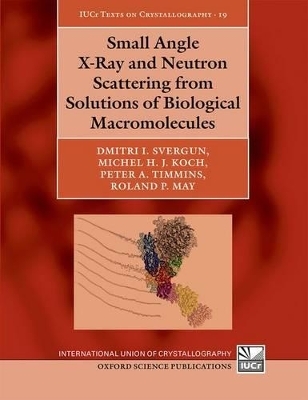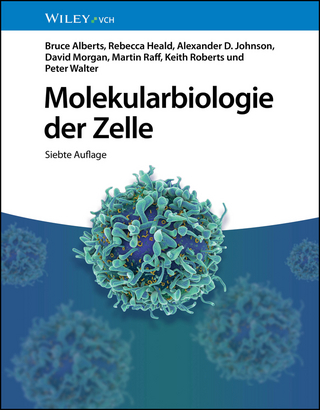
Small Angle X-Ray and Neutron Scattering from Solutions of Biological Macromolecules
Oxford University Press (Verlag)
978-0-19-963953-3 (ISBN)
Small-angle scattering of X-rays (SAXS) and neutrons (SANS) is an established method for the structural characterization of biological objects in a broad size range from individual macromolecules (proteins, nucleic acids, lipids) to large macromolecular complexes. SAXS/SANS is complementary to the high resolution methods of X-ray crystallography and nuclear magnetic resonance, allowing for hybrid modeling and also accounting for available biophysical and biochemical data. Quantitative characterization of flexible macromolecular systems and mixtures has recently become possible. SAXS/SANS measurements can be easily performed in different conditions by adding ligands or binding partners, and by changing physical and/or chemical characteristics of the solvent to provide information on the structural responses. The technique provides kinetic information about processes like folding and assembly and also allows one to analyze macromolecular interactions.
The major factors promoting the increasingly active use of SAXS/SANS are modern high brilliance X-ray and neutron sources, novel data analysis methods, and automation of the experiment, data processing and interpretation.
In this book, following the presentation of the basics of scattering from isotropic macromolecular solutions, modern instrumentation, experimental practice and advanced analysis techniques are explained. Advantages of X-rays (rapid data collection, small sample volumes) and of neutrons (contrast variation by hydrogen/deuterium exchange) are specifically highlighted. Examples of applications of the technique to different macromolecular systems are considered with specific emphasis on the synergistic use of SAXS/SANS with other structural, biophysical and computational techniques.
Dmitri I.Svergun: MSc in Solid state physics (1980), Physics Department, Moscow State University, Russia; PhD in Physics and Mathematics (1982) and Dr. of Science (1997), Institute of Crystallography, Moscow, Russia; Engineer, Researcher, Senior Scientist at the Institute of Crystallography, Russian Academy of Sciences, Moscow (1980 - 2008); Guest scientist, GKSS Research Centre, Geesthacht, Germany (1990-1991); Visitor, Staff Scientist, Group Leader, at the European Molecular Biology Laboratory Hamburg Outstation (1991-present). Michel, H.J. Koch: PhD in chemistry, University of Louvain (1970), Neutron scattering on biological macromolecules in solution (1974-1976). Consultant (1975-1976), Group leader at the European Molecular Biology Laboratory outstation at DESY, Hamburg (1977-2006), Visiting professor at the Faculty of Engineering and Natural Science, Sabanci University, Turkey (2008-2009) and the Chemistry Department, University of Leuven (2006 - present). Roland May: Diploma in Physics (Technische Universität München); Thesis work at the Max-Planck Institut für Biochemie, Martinsried; PhD Technische Universität München 1978; scientist in the Large-Scale Structures group of the Institut Laue-Langevin, Grenoble until 2008; retired. Peter Timmins: BSc in Chemistry (1967), MSc in Crystallography (1968) and PhD in Crystallography (1972) - Birkbeck College, University of London. Instrument Scientist, Institut Laue-Langevin, 1975 - 1993, Head, Large Scale Structures Group, Institut Laue-Langevin, 1993 - 2010. Since 2010, retired.
Introduction ; PART I. THEORY AND EXPERIMENT ; 1. Basics of small-angle scattering ; 2. X-ray and neutron scattering instruments ; 3. Experimental practice and data processing ; PART II. DATA ANALYSIS METHODS ; 4. Monodisperse systems ; 5. Polydisperse and interacting systems ; PART III. BIOLOGICAL APPLICATIONS OF SOLUTION SAS ; 6. Static structral studies ; 7. Kinetic and perturbation studies ; 8. Analysis of interparticle interactions ; 9. SAS in multidisciplinary studies ; Conclusions and future outlook ; Appendix 1: Waves, complex number, Fourier transforms, convolution, correlation ; Appendix 2: Spherical harmonics formalism ; Appendix 3: Interactions between spherical molecules ; Appendix 4: List of Web resources
| Erscheint lt. Verlag | 8.8.2013 |
|---|---|
| Reihe/Serie | International Union of Crystallography Texts on Crystallography ; 19 |
| Zusatzinfo | 126 b/w illustrations |
| Verlagsort | Oxford |
| Sprache | englisch |
| Maße | 196 x 247 mm |
| Gewicht | 982 g |
| Themenwelt | Naturwissenschaften ► Biologie ► Biochemie |
| Naturwissenschaften ► Biologie ► Genetik / Molekularbiologie | |
| Naturwissenschaften ► Geowissenschaften ► Mineralogie / Paläontologie | |
| Naturwissenschaften ► Physik / Astronomie ► Angewandte Physik | |
| ISBN-10 | 0-19-963953-1 / 0199639531 |
| ISBN-13 | 978-0-19-963953-3 / 9780199639533 |
| Zustand | Neuware |
| Haben Sie eine Frage zum Produkt? |
aus dem Bereich


